Abstract
This study investigated the effect of compression garments (X) on cycling performance in the heat (32 °C) and tested the hypothesis that X would not negatively affect cycling performance in the heat by comparing X and traditional cycling garments (C). Seven amateur cyclists and triathletes performed an incremental test followed by 20 min cycling performance test at a power that elicited the subject’s pre-determined 80 % of ventilator threshold and then a time to exhaustion (TTE) at VO2max power (PPO) for both X condition and C condition (randomized). Oxygen uptake (VO2) and heart rate were collected during steady state of sub-maximal intensity, TTE was taken at the end of maximal aerobic intensity and rating of perceived exertion, thermal and sweating sensation were provided every 5 min during the test. All parameters were compared between X and C; no significant differences (p < 0.05) were found, so the initial hypothesis was confirmed.






Similar content being viewed by others
References
Agu O, Baker D, Seifalian AM (2004) Effect of graduated compression stockings on limb oxygenation and venous function during exercise in patients with venous insufficiency. Vascular 12(1):69–76
White JV, Ryjewski C (2005) Chronic venous insufficiency. Perspect Vasc Surg Endovasc Ther 17(4):319–327
Ibegbuna V et al (2003) Effect of elastic compression stockings on venous hemodynamics during walking. J Vasc Surg 37(2):420–425
Hamann JJ et al (2003) Muscle pump does not enhance blood flow in exercising skeletal muscle. J Appl Physiol 94(1):6–10
Bringard A, Perrey S, Belluye N (2006) Aerobic energy cost and sensation responses during submaximal running exercise: positive effects of wearing compression tights. Int J Sports Med 27(5):373–378
Sperlich B et al (2010) Different types of compression clothing do not increase sub-maximal and maximal endurance performance in well-trained athletes. J Sports Sci 28(6):609–614
Vercruyssen F et al (2012) The influence of wearing compression stockings on performance indicators and physiological responses following a prolonged trail running exercise. Eur J Sport Sci, 2012 (ahead-of-print), 1–7
Dascombe BJ et al (2011) The effects of wearing undersized lower-body compression garments on endurance running performance. Int J Sports Physiol Perform 6(2):160
Duffield R, Portus M (2007) Comparison of three types of full-body compression garments on throwing and repeat-sprint performance in cricket players. Br J Sports Med 41(7):409–414
Brandon D et al (2003) Evaluation of a lower-body compression garment. J Sports Sci 21(8):601–610
Brownlie L, MEKJAVC I, Banister E (1987) Thermoregulation in athletic racing apparel. Ann Physiol Anthropol 6(3):145–155
Goh SS et al (2011) Effect of lower body compression garments on submaximal and maximal running performance in cold (10 °C) and hot (32 °C) environments. Eur J Appl Physiol 111(5):819–826
Hassmen P (1998) Overtraining and recovery: a conceptual model. Sports Med 26(1):1–16
Galloway S, Maughan RJ (1997) Effects of ambient temperature on the capacity to perform prolonged cycle exercise in man. Med Sci Sports Exerc 29(9):1240
Gavin TP et al (2001) Clothing fabric does not affect thermoregulation during exercise in moderate heat. Med Sci Sports Exerc 33(12):2124
Bentley DJ, Newell J, Bishop D (2007) Incremental exercise test design and analysis: implications for performance diagnostics in endurance athletes. Sports Med 37(7):575–586
Beaver WL, Wasserman K, Whipp BJ (1986) A new method for detecting anaerobic threshold by gas exchange. J Appl Physiol 60(6):2020–2027
Dupont G, Blondel N, Berthoin S (2003) Time spent at VO2max: a methodological issue. Int J Sports Med 24(4):291–297
Herman L et al (2009) Validity and reliability of the session RPE method for monitoring exercise training intensity. S Afr J Sports Med 18(1):14–17
Abbiss CR et al (2010) Examining pacing profiles in elite female road cyclists using exposure variation analysis. Br J Sports Med 44(6):437–442
Gill N, Beaven C, Cook C (2006) Effectiveness of post-match recovery strategies in rugby players. Br J Sports Med 40(3):260–263
Conflict of interest
None.
Author information
Authors and Affiliations
Corresponding author
Rights and permissions
About this article
Cite this article
Brighenti, A., Bortolan, L., Savoldelli, A. et al. Effect of new type of compression garments on sub-maximal and maximal cycling performance in the heat (32 °C). Sport Sci Health 9, 127–131 (2013). https://doi.org/10.1007/s11332-013-0158-5
Received:
Accepted:
Published:
Issue Date:
DOI: https://doi.org/10.1007/s11332-013-0158-5




